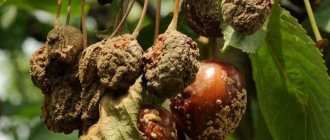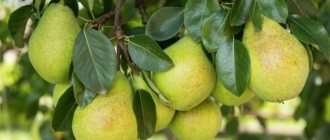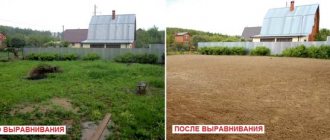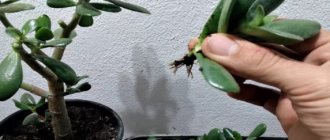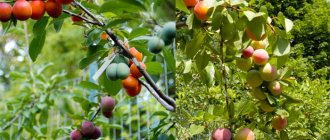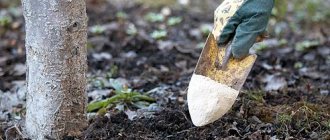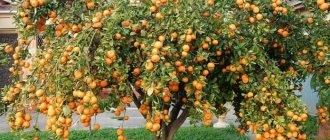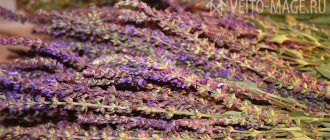What to water a tree to make it die. How to water a tree so that it dries out quickly?
Every gardener plans the placement of trees and shrubs on his site to create a beautiful landscape and comfort. Naturally, during the process, the thought does not occur to anyone that there will be a need to destroy the plantings. Unfortunately, this happens quite often. If a tree is diseased or has grown so much that it poses a threat to the lives of people or the integrity of buildings, it must be eliminated.
It is not always possible to simply cut down the trunk. In this case, special chemicals are used. They need to water the tree so that it dries out and makes it easier to cut it into pieces and remove it from the site. From this article you will learn what substances can be used for these purposes.
How to make a tree dry out
There are many ways to artificially dry a tree, both scientifically based and folk. Chemical agents are considered more effective; although they pose a certain danger to the soil and humans, they still allow you to quickly dry even a large specimen.
There are several ways to destroy garden trees:
- Watering the leaves and bark with a solution of chemicals;
- Application of special preparations to leaf plates;
- Inoculations of toxic substances that quickly penetrate the juices of the plant and destroy it;
- Placing the poison in the soil near the roots of the plant.
From a technological point of view, the tree does not need to be destroyed: it is enough to simply cut it down and treat the remaining stump with chemicals to destroy it. However, if you need to act quickly, the advantage is still given to chemicals.
But, after the tree has dried, it needs to be recycled. How to do it correctly - the author tells
Chemicals for killing trees
It is not difficult to destroy a tree using chemicals, especially since every gardener has most of them (Figure 1).
The most effective means include:
- Sodium nitrate: Most often used to kill tree stumps, but it can also be used on mature stumps. To make it dry within a year, you need to drill a hole in the trunk and inject a chemical into it. If this is not possible, you can simply water the soil around the plant with a solution of nitrate, but in this case the drying process will take several years.
- Ammonium nitrate: uses the same principle as sodium nitrate, but certain differences between these substances still exist. Ammonium nitrate is produced from urea, which accelerates the process of wood decomposition, so it is most often used to treat stumps and exposed root systems.
- Picloram: another effective remedy that acts directly on the root system. The substance inhibits the roots and the crop gradually dries out.
Figure 1. The main chemicals for destroying trees: sodium nitrate, ammonium nitrate, the drug Picloram.
In addition, to destroy plantings, you can use conventional herbicides, as well as special preparations, arboricides, which are intended specifically for treating trees and large shrubs. We will consider the features of the effects of these substances in more detail.
Arboricides
In fact, arboricides belong to the group of herbicides because they are intended to control vegetation. The only difference is that arboricides are used exclusively to destroy trees and shrubs (Figure 2).
The substance must be diluted with water and sprayed with the prepared solution. It is better to carry out the procedure in early spring so that the substance does not accidentally get on other plants. However, if the need for treatment arose in the middle of the season, it is better to use another method: drill a hollow in the trunk and place the drug there. In this case, the aroboricide will only affect the selected crop. In this case, it is advisable not to plant and harvest in this place during the year.
How to prepare poison for plants at home
A good way to get rid of unwanted vegetation is to treat with a vinegar solution. Add 100 grams of citric acid or lemon juice to a liter of 20% vinegar. This solution is sprayed on the top of the plants.
Using salt
Sodium chloride or table salt is the enemy of vegetation. To prepare the poison, you need to add 2 cups of salt to 4 liters of water. After the crystals have completely dissolved, you need to spray the above-ground part of the plants.
In fact, getting rid of weedy trees and bushes can be done quickly and easily. You can prepare an effective poison for plants at home. The main thing is to approach the procedure competently, and to carry out treatment with chemicals very carefully so as not to damage the “necessary” plants.
Water the tree with salt water. Traditional methods
“Old-fashioned” remedies are effective if gentle methods of renewing plantings are a priority.
Mulch
The option is relevant if the problem is being solved, what to do and what to do so that the tree dries out for “natural” reasons. Mulching the trunk to a greater height will help eliminate a young tree with a sensitive root system. To do this, make a backfill of crushed weeds to a height of about 0.5 meters. Any mulch will do, including sawdust, hay, humus, and peat.
You can also use potato peelings, vegetable tops, fallen leaves and other formulations. The goal is to prevent oxygen from reaching the root system. Lack of air circulation leads to accelerated decay; caustic substances and thermal energy released in the process quickly corrode the bark. As a result, the roots die and the tree dies.
Salt
Watering with a high concentration saline solution is effective if you need to destroy a not very old tree. However, in order to eliminate a powerful culture, you will have to spend a long time and regularly spend time and energy, and spend money on buying large quantities of salt. The solution is prepared in a 1:1 ratio and watered from the beginning of the growing season until autumn frosts. If desired, you can build a trench around the trunk, add salt, and cover it with a layer of soil on top. After the tree dries out, the soil will have to be renewed. It takes several years to naturally restore soil fertility.
Salt is a folk remedy for drying out a tree.
Concrete
To get rid of a powerful crown that interferes with the construction of, for example, a garden sidewalk, it is recommended to pave the roots. The procedure involves digging a circle around the perimeter of the trunk to a depth of 50-70 cm, depending on the nature of the root system. The prepared trench around the tree is filled with concrete mortar. At the same time, access to air and nutrients is blocked, which leads to the death of the roots.
Useful tips and tricks
The destruction of trees on a personal property is the responsibility of its owner. To avoid causing damage to other plants and the environment, you must adhere to the following rules:
- strictly follow the instructions of the herbicide developer;
- mark already processed trees;
- administer drugs through the incisions immediately, preventing the bark tissue from drying out;
- protect the desired crops from accidental contact with the solution;
- carry out the treatment by applying or spreading to the width of the crown.
What happens if you water a tree with salt water? How to kill a disturbing tree easily and quickly?
Experienced gardeners recommend drilling an inclined hole in the trunk so long that it reaches the core of the trunk, and pouring liquid into it, which will begin to destroy the tree from the inside. It can be a strong acid - acetic, hydrochloric, formic. The acid kills the tree within a week.
Ask the railroad workers for a solution of dichlorophenoxyacetic acid, which they use to control brush and vegetation along the railroad tracks. This agent is also introduced into the hole drilled at an angle.
You can pour gasoline, diesel fuel, acetone into the hole - the effect will be the same. Don’t forget about herbicides - they destroy not only weeds, but also quite large trees. These are herbicides with glyphosphate Tornado, Arsenal and other products with a similar composition.
Herbicides are used in the same way as acids; after pouring in the killing liquid, the hole is closed with clay, putty, or garden varnish so that the liquid does not evaporate.
To kill a tree, you can spray its leaves with Roundup diluted in water in a strong concentration. First, the product destroys the leaves, then it dries itself, deprived of the possibility of photosynthesis and the production of necessary nutrients. Roundup can also be injected into a tree trunk, just as described above.
Experts recommend applying herbicides to cuts on the bark of trees, but not in the spring, since sap flow prevents the absorption of the drug.
In addition, herbicides are applied directly to the bark in the lower part of the trunk - at a distance of 30-50 cm from the ground. This procedure is carried out from spring to early autumn. To prevent the herbicide from dripping from the bark, it is mixed with oil and coated with it on the bark.
There are special herbicides for the destruction of large trees and shrubs, arboricides; buy and apply them in accordance with the instructions.
It is believed that a copper nail driven into it can easily and quickly kill a tree; it may not be possible to destroy a large tree with one nail; several nails will be needed.
A small tree can be destroyed by burying several old batteries next to it, but their acid is harmful and dangerous for all living things.
An interfering tree can be killed without cutting it down, using salt - it is introduced in a solution with water - by watering the tree, or simply by burying it under the roots. It is advisable to apply salt under the central root, but it is also acceptable to apply saline solution under the peripheral shoots. At the same time, keep in mind that the roots of the tree grow unevenly - on the eastern side they extend to a distance equal to the height of the crown, and on the western side - to half the height.
Using this feature of the root system, some summer residents try to destroy a neighbor's tree without penetrating into someone else's plot. They just bury the salt at the fence next to the tree and that’s it. At the same time, no efflorescence occurs on the soil, and it can be very difficult to prove their malicious intent. The salt method works for 1-2 months - first the tree sheds its leaves and then dries out.
But we should not forget that salt in the soil will negatively affect other plants, as well as the water in the well or borehole. Water and soil are also polluted by other agents applied directly under the roots - herbicides, gasoline, diesel fuel, acids. Therefore, you need to act with them thoughtfully and carefully.
There is an ecological method of “killing” a tree. Reliably, but not very quickly, it is killed by a decorative vine with a characteristic name - wood pliers. This beautifully flowering vine entwines itself with a tree trunk and is attached to it not with suction cups or tendrils, like other vines, but with sharp thorns. As a result, the tree dies, and now it is important not to let it spread to other, necessary and useful trees. A wood plier is used when it is not the tree itself that is in the way, but its roots.
Popular chemicals for killing trees
Not all herbicides are effective in controlling woody vegetation, since many of them are designed to eliminate grass weeds.
Let's look at which herbicides successfully kill trees.
| Active substance | Effect on weed | Drug name | Target objects |
| 1, 2, 4-D (1, 2, 4-Dichlorophenoxyacetic acid), aquaclean | Leaves curl, top roots rot | 2,4-D Active, Icon, Crossbow, Ballerina, Vsplokh, Prima, Diva Super, Svarog, Effect. | Alder, willow, aspen, downy and warty birch, hazel, bird cherry, spruce, buckthorn, honeysuckle, rowan, stone fruits, pome fruits, citrus fruits |
| Glyphosate (isopropylamine salt) | Accumulates in tissues, disrupting physiological processes | Argument, Helios, Judo, Zero Super, Zero, Roundup Max, Smerch, Tornado 500 For private household plots: Agrokiller, GliBest, Napalm, Swift, Typhoon, Roundup, Clean, Zeus. | Hardwood species |
| Glyphosate (potassium salt) | Accumulates in the active growth zone, stopping the growing season | Helios, Roundup, Octopus, Tornado 540, Total | Woody and shrub vegetation, allowed to be used in vineyards |
| Picloram (dimethylethanolamine salts) | Suppresses the synthesis of bioactive acids, reduces CO absorption. | Actaeon, Galera, Galion, Rapsan, VR with | Shrubs that reproduce by root shoots |
| Prometrin, Gesagard | Suppresses photosynthesis. | Alpha-Prometrin, Gambit, Gesagard, Honor, Positive Plus, Promex, Prometrin, Sarmat. | Woody vegetation |
The drug "Roundup" is approved for use against weeds in cultivated plantings and forests occupied by cedar, pine, and spruce.
Before working with herbicides, you must carefully study the instructions. During work, precautions are taken, taking into account harm to animals, incl. insects Store medications according to recommendations.
Subtleties of the procedure
Before offering specific instructions, let us dwell on the rules that must be taken into account when conducting events:
- The most appropriate time to apply chemicals is spring and summer, when active sap flow occurs.
- Herbicides have a detrimental effect on the soil. They are used with caution and strictly according to the instructions. The drug is dangerous for domestic animals, birds, and insects.
- It is necessary to introduce the chemical into the tree immediately after creating a cut or hole. Otherwise, the plant will heal the wound and the effectiveness of the effect will sharply decrease.
- When choosing how to quietly dry a standing tree, you should take into account the presence of other plants nearby. If their root system is located close, then the chemicals will affect all nearby flora representatives.
- Salt is used carefully, since in the future the soil will be unsuitable for planting. To restore the soil, you will need to add a lot of lime, dolomite flour, and wood ash.
- Before applying the chemicals, they are tinted with a dye - this will allow you to quickly identify the wood that has already been treated.
- The work is carried out in dry weather, with moderate temperatures and without wind.
Protection against the development of putrefactive processes in wooden structures
To ensure that a wooden log house, a log house, a bathhouse or other outbuildings made from this building material are not subject to rotting, you must adhere to all the rules for protecting the structure. Measures to prevent wood contamination by fungi and mold are:
Proper foundation waterproofing will protect the house from rotting.
- Arrangement of waterproofing of the foundation, drainage system for removing ground and surface water.
- Coating wood with paints and varnishes.
- The presence of a waterproof roof of the building.
- Creating room ventilation using vents.
- Correct installation of insulating layers on the walls of structures in order to prevent the accumulation of condensation (vapor barrier - inside the room, and thermal insulation membrane - outside).
- Protection of the ends of the logs by especially careful treatment with antiseptics or additional covering with boards.
In the case when a wooden structure is subjected to periodic moisture, only strong antiseptic agents stop rotting (for example, double-action chemicals “Neomid 400”, “Neomid 500”, which protect against moisture and rot). In this case, already rotten wood is completely cut down, removed from the premises and burned to avoid further contamination of the tree.
Related article: Do-it-yourself electrical wiring in the house step by step
For preventive purposes, wooden buildings should be carefully inspected annually for damage by parasitic fungi. If lesions are detected, either the wooden element is completely replaced, or the infected area is cut down and subsequent antiseptic treatment is carried out.
Causes of putrefactive processes, their types and stages
Biological destruction of wood is triggered in the following circumstances:
Wood rot often occurs due to dampness.
- damp and warm climate;
- availability of oxygen;
- The internal humidity of the wood itself is above 18-20%.
These factors provide the opportunity for various fungi to parasitize wood and cause putrefactive processes. Thus, freshly cut logs in felling areas and piles of lumber in warehouses can be affected by the warehouse and pole fungus. And building materials and wooden structures made of both deciduous and coniferous wood can suffer due to the wood-destroying effects of many varieties of house mushrooms (real, white, membranous, etc.).
The type of decay depends on the tree’s own physical qualities and the type of fungus parasitizing on it.
For the destructive type, provoked by the larch sponge, sulfur-yellow, bordered and other tinder fungi:
When wood rots, cracks appear.
- Wood becomes smaller in volume.
- Cracks appear.
- The color of the tree varies from reddish to brown and dark brown.
- The wood structure becomes fragile.
- The wood disintegrates into pieces in the form of cubes and prisms, and then it crumbles into powder.
Related article: Assembling curtain rods: length calculation, tips
For corrosive putrefactive damage:
- Wood does not lose viscosity and volume.
- The destruction is partial and alternates with healthy areas.
- Cells and pits first appear in the wood material, then it begins to delaminate into fibrous layers.
- The color of wood affected by fungi becomes variegated (white lesions on a brown base) or very light (white, light yellow or marbled).
The cause of variegated rot is fungi such as sponges (pine, root, spruce) and tinder fungi (oak, spruce butt). The white color is caused by honey fungus and tinder fungus (flat, false, true).
Cleaning sewer pipes
Tree roots can penetrate sewer pipes, causing damage to the entire water supply. This is why pipes also need to be cleaned. Special services should deal with this. The plumber will clean the pipes mechanically. In addition, it will not harm the environment at all. If the pipes become seriously damaged, they will have to be replaced.
However, if the services do not respond, you can independently clean the sewer pipes from tree roots. There are two proven methods:
- Pouring copper sulfate or rock salt into the toilet. This method is the simplest, because you don’t even need to leave the apartment. However, the method has a significant disadvantage - the substances can harm the tree and lead to its death. It is strictly prohibited to pour products into a sink or shower, since the substances will remain on the walls and there will be indirect contact with a person. In total, no more than 0.9 kilograms of copper sulfate or rock salt should be poured into the toilet. This needs to be done in portions - ¼ kilogram at a time. Do not rinse off the water for 8-12 hours, otherwise the substances will be washed away with water before the roots are destroyed. During work, you should follow the instructions and safety rules.
- Treatment of sewer pipes with herbicides in the form of aerosols. This method is the most convenient, because the spray fills the pipes, eliminates the roots, and disintegrates after a while. The best choice is contact chemicals: they act quickly without affecting the tree. Systemic herbicides destroy roots more slowly (at least 2 weeks), and they can also have a detrimental effect on the health of the tree. When purchasing, you should read the instructions to be sure that the aerosol is suitable for the pipe (its diameter plays an important role). It is also necessary to take into account the danger of the herbicide for fish and animals, especially if there are bodies of water nearby.
Using these methods, you can clear pipes of tree roots. And in order to completely destroy a tree or stump on a site, you just need to choose the most convenient method for yourself. Fortunately, there are many options for how to get rid of roots. The methods differ in both application and speed of achieving the effect. In any case, you will be able to achieve what you want, and the problem of overgrown roots or a stump in your summer cottage will no longer bother you.
